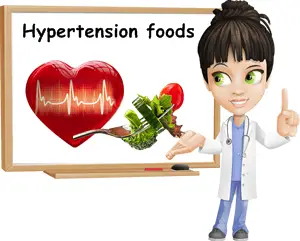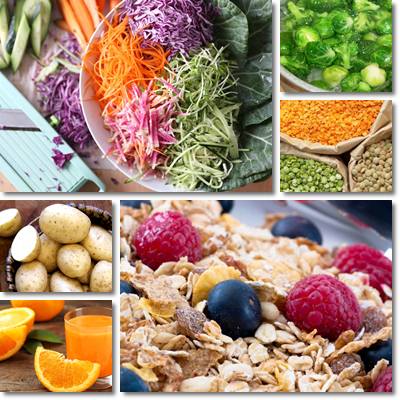High blood pressure or hypertension generally refers to blood pressure readings over 139/89 mmHg, or, to round values a bit, over 140/90 mmHg, in which the unit of measurement mmHg stands for millimeters of mercury.
If left untreated, hypertension will, in time, lead to cardiovascular disease and premature death. But despite the poor prognostics and high mortality rates of cardiovascular disease, hypertension is perfectly reversible and all we need to do is simply eat and live in a healthier manner.
In other words, if we took care of ourselves and paid attention to what we ate, then we would not be suffering from high blood pressure at all. Statistically speaking, up to 90% of hypertension cases are a result of poor eating habits and, of course, bad lifestyle habits such as smoking or alcohol consumption.
For this reason, the main aspect that needs to be addressed when attempting to reverse or treat hypertension is nutrition. And this is not science fiction: it’s simply science.

The same medical professional that will prescribe us medication for hypertension will advise us to also reduce our salt intake, drink less coffee, sodas or green tea, give up smoking, alcohol and eat right (he or she may not dwell on the eating right part because that is a nutritionist or dietitian’s area of expertise and they feel they may not have the right qualifications to propose a specific meal plan).
In other words, we are being given medication for hypertension to keep us going while we make the necessary changes to help our body really get well and function the same way it did before we developed the condition.
Hypertension medicines do not, in truth, cure hypertension, but rather manage it. If they did, we wouldn’t have to take them all the time. Eating right on the other hand will have a considerably deeper, long-term impact on our health by giving our body the nutrients it needs to treat the disease, the core problem and revert it to a healthy state.
Good nutrition is fundamental for keeping healthy. Eating right can have a deep, positive impact on the most diverse of illnesses, afflictions and conditions, from fatigue, hormonal imbalances, allergies and laryngospasm to heart disease, diabetes, arthritis and cancer.
So what should we eat for hypertension? The best foods to eat for hypertension are those rich in particular nutrients such as potassium, magnesium, vitamin C, dietary fiber, antioxidants and healthy Omega-3 fatty acids.

What to eat for Hypertension
1) Potassium-rich foods.
Potassium is an electrolyte which helps regulate the fluids in our body. It helps counteract the effects of sodium, preventing water retention and regulating blood pressure.
Of all nutrients, potassium has the most visible impact on high blood pressure and almost immediate effects. The average adult is said to require about 3,500-4,700 mg of potassium a day. Some of the best sources of potassium include:
(Fresh and dried fruits) dried apricots (without sulfur preservatives, 400 mg/ 5 fruits), bananas (420 mg/ medium-sized banana), cantaloupe (430 mg/cup), undiluted orange juice, pumpkin, tomatoes, dried plums.
(Nuts and seeds) almonds (705 mg/100 g), peanuts (705 mg/100 g), cashews (660 mg/100 g), sunflower seeds (645 mg/100 g), pistachios and most nuts and seeds.
(Vegetables) baked potatoes (600 mg/ medium-sized potato), boiled beet greens (1300 mg/ cup), boiled lentils (731 mg/cup), baked sweet potato with skin (700 mg/ medium-sized potato, 150 g), winter squash (900 mg/cup), cooked broccoli (450 mg/cup), cooked beets (500 mg/cup), Brussels sprouts (490 mg/cup).
(Legumes) canned white beans (almost 600 mg/half a cup), cooked lentils (360 mg/half a cup).
2) Magnesium-rich foods.
Magnesium is a dietary mineral of great importance for cardiovascular health because it supports muscle health. Our heart being a muscle as well, magnesium contributes to its good functioning too.
The average adult requires a minimum of 310-420 mg of magnesium a day. Nuts, seeds, dried fruits, green leafy vegetables, chocolate and whole grains are some of the best dietary sources of magnesium.
(Nuts and seeds) cashews, almonds, peanuts, pecans, hazelnuts, walnuts and Brazil nuts.
(Whole grains) bran, whole wheat, whole barley, oats, brown rice, corn meals and rye.
(Vegetables) beet greens, chard, spinach, all types of beans, peas and seaweed.
(Dried fruits) dried apricots, dried figs, dried dates.
(Seafood) shrimp, crab, clams, cockles, conch, winkles (tiny, edible sea snails).
(Fresh fruits) bananas, blackberries, avocado, raspberries, peaches, apricots, olives, figs, quinces, currants (generally low in magnesium).
3) Foods rich in vitamin C
Vitamin C is the ultimate super-nutrient. Not only does it boast excellent antioxidant, antiproliferative and anti-inflammatory properties, but it is also a potent antihistamine, antiviral and antibacterial.
It is involved in a wild number of basic metabolic processes in our body and contributes to detoxifying the body of toxins, both at cell level and the the level of the digestive tract.
Vitamin C for cardiovascular health helps maintain the elasticity of the blood vessels (it is responsible for collagen production) and helps cleanse them of cholesterol deposits.
More important, the nutrient is a diuretic which means it helps eliminate excess water in the body and, along with it, excess sodium, a mechanism that efficiently lowers blood pressure.
The recommended daily requirements of vitamin C are low: about 90 mg a day. But this is a minimum amount meant only to prevent a deficiency and it does not really do anything to improve our health.
Novelty research shows that amounts as high as 1,000 mg, 2,000 mg or 5,000 mg (1, 2 or 5 g) should be the minimum daily intake for an average person, especially since there is no toxicity associated with vitamin C intake.
To put things into perspective, consider this: amounts as high as 20,000 mg (20 g) and even 50,000 mg (50 g) of vitamin C are used to treat cancer patients and consistent treatment has lead to rapid tumor shrinking and complete cancer withdrawal, without other side effects than occasional diarrhea or wooziness.
Even more, the Johns Hopkins journal of medicine suggests that high doses of vitamin C (500 mg or 0,5 g) can lower hypertension up to 5 mmHg (Big Doses of Vitamin C May Lower Blood Pressure). They also advise not to take so much because it may be harmful, yet they cannot say what are the possible side effects and there is really no research up to this point that can show what harm vitamin C can do. Research on the cardiovascular benefits of vitamin C is plentiful (see Linus Pauling’s findings), yet not utilized.
But as far as science is concerned, high doses of vitamin C can help reverse high blood pressure. Foods such as red and green bell peppers, kiwifruit, strawberries, broccoli, cantaloupe, Brussels sprouts, citrus fruit are the highest, commonly available sources of the nutrient.
However, the Kakadu or billy goat plum and camu camu are the best sources, with camu camu containing 1880-2280 mg of vitamin C/100 g and the Kakadu plum estimated to have at least 1,200 mg of vitamin C/ 100 g.
But because not all of us can eat camu camu or Kakadu (billygoat plums) everyday, supplements are a great way to supply our body with what it’s missing and restore our cardiovascular health.
4) Foods rich in dietary fiber
Nuts and seeds, whole grains, dried fruits, vegetables and most fruits are all excellent sources of dietary fiber. Dietary fiber is basically indigestible plant material that passes unchanged through our intestines. But as it makes its way out, it takes part of the fats we ingest with it. This indirectly contributes to lower cholesterol levels. This, in turn, means our blood vessels are less likely to develop cholesterol plaques that narrow them, making blood flow more difficult.
Narrower blood vessels also causes hypertension, hence the importance of dietary fiber for hypertension management. Add a healthy intake of green leafy vegetables rich in vitamin K to help better distribute calcium in the body (artery plaques contain calcium bits as well).
5) Plant and animal Omega-3 sources
In addition to improving total cholesterol levels (lowering LDL and raising HDL cholesterol), Omega-3 fatty acids reduce inflammation and help clear plaque buildup from artery walls. This, in turn, contributes to lowering blood pressure.
Some of the best sources of Omega-3 include fish and seafood such as cod, tuna, salmon, sardines, herring, halibut or mackerel as well as purslane, walnuts, hazelnuts, flax seeds, chia seeds, pumpkin seeds, sunflower seeds etc.
Conclusion
When it comes to hypertension, it is important to make sure you give your body the nutrients it needs in the amounts it needs. But to do this, one must set aside any food that isn’t contributing in any way towards lowering hypertension to make room for foods that actually contribute to cardiovascular health. Only then will the healing process begin.
